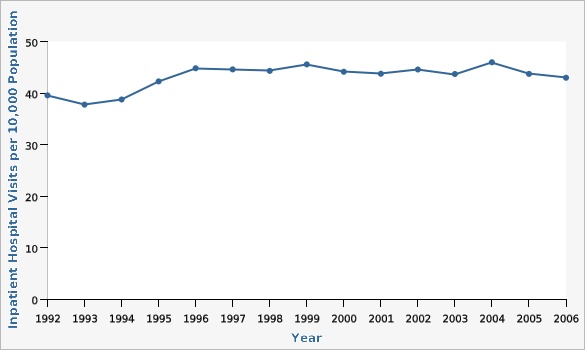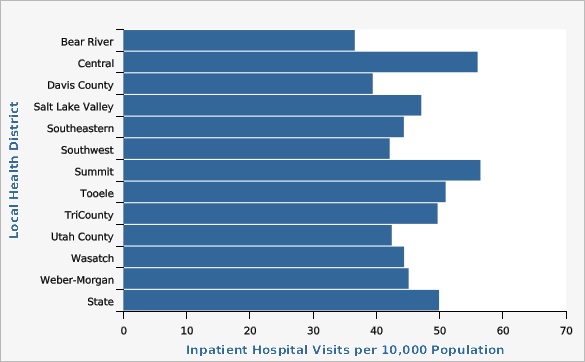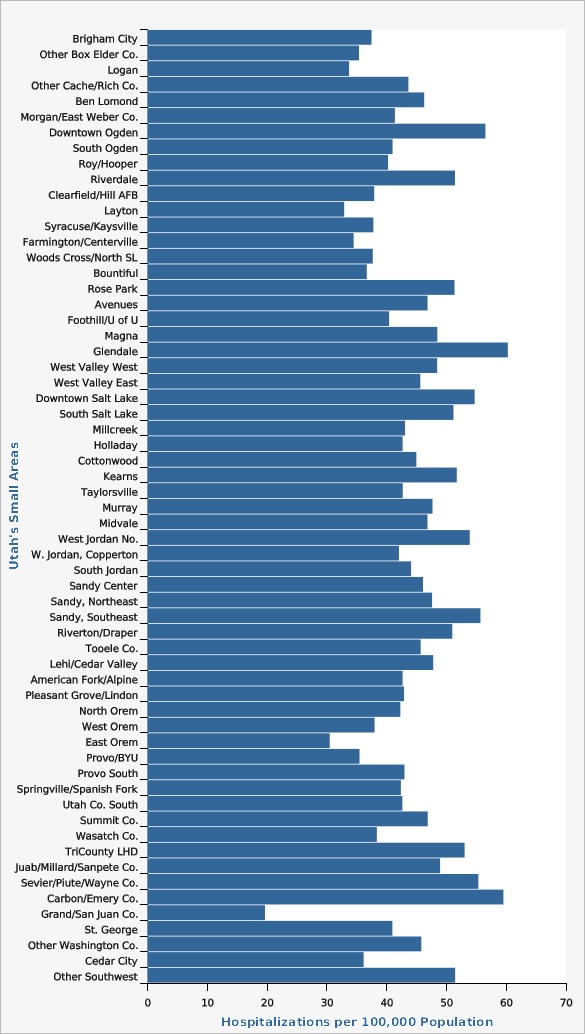Complete Health Indicator Report of Unintentional Injury Hospitalizations
Definition
The number of unintentional injuries among Utah residents per 10,000 persons as reported in hospitalization records.Numerator
Number of unintentional injuries reported in hospitalization records among Utah residents.Denominator
Total population of Utah.Data Interpretation Issues
The hospital and emergency department data were created for use in billing and remittance of payment, not for public health surveillance. Therefore, the data are weak in some areas, such as external cause of injury and race or ethnicity.Why Is This Important?
Since 1992, there have been approximately 8,120 unintentional injury hospitalizations of Utah residents each year. Injuries do not happen by chance and the events leading up to injuries are not random. Choosing safe behaviors, using safety equipment, and obeying safety laws can prevent most unintentional injuries. The top 3 leading causes of unintentional injury hospitalizations in 2006 in Utah were falls, motor vehicle crashes, and poisoning.Other Objectives
Violence and Injury Prevention Program, Utah Department of Health: By 2010, reduce hospitalizations due to falls among Utah residents 65 years of age and older to 1,200 per 100,000. By 2010, reduce deaths caused by unintentional injuries to no more than 27.9 per 100,000 Utah residents. By 2010, increase bicycle helmet use among elementary school-age children in Utah to 25 percent. By 2010, increase the use of vehicle safety restraints among child occupants 8 and under in Utah to at least 75 percent. By 2010, reduce pedestrian deaths on public roads caused by motor vehicles to no more than 1 per 100,000 Utah residents each year.How Are We Doing?
Data indicate the number of unintentional injury hospitalizations has fluctuated around the 15-year average of 36.81 injuries per 10,000 population in Utah. The lowest rate was seen in 1993, with a rate of 34.03 injuries per 10,000 population; the highest was in 1997 at 38.45 per 10,000 population. The most recent rate available is for 2006, at 36.39 per 10,000 population.What Is Being Done?
The UDOH Violence and Injury Prevention Program (VIPP) provides funding, training, and technical assistance to local health departments to conduct education programs on the following topics: child safety seats, seat belt use, pedestrian safety, bicycle safety, DUI prevention, ATV and off-road safety, fire prevention, safe firearm storage, and drowning prevention. In addition, VIPP promotes bicycle and pedestrian safety by distributing free and low-cost bicycle and ski helmets and providing bike and pedestrian safety information. VIPP is the lead organization for Utah Safe Kids, a coalition working to prevent childhood injury. To help reduce fall-related hospitalizations and deaths, VIPP is working with local health departments and other partners to promote health, home safety, and fall prevention programs for older adults.Available Services
Utah Department of Health, Violence and Injury Prevention Program Services provided: pedestrian and bicycle safety, child safety seat inspections, bicycle rodeo trailer Information provided: seat belt use, child safety seat and booster seat use, pedestrian safety, bicycle safety, helmet use, fall prevention, drowning prevention, playground safety, school safety, traumatic brain and spinal cord injury prevention Telephone: 801-538-6141 Web site: www.health.utah.gov/vipp Safe Kids Utah Services provided: child safety seat and booster seat inspections and low cost bike and ski helmets Information provided: child safety newsletter, traffic safety, pedestrian safety, car seat and booster seats, bike safety, home safety, firearms, recreation safety, and drowning prevention Telephone: 801-538-6852 Web Site: www.utahsafekids.org Utah Highway Safety Office Services provided: child safety seat inspections, motor vehicle safety presentations, Information provided: MV crash statistics, DUI, graduated licensing, seat belt use, child safety seats, booster seats, pedestrian safety, bicycle safety Telephone: 801-293-2480 Web Site: www.highwaysafety.utah.govHealth Program Information
The mission of the UDOH Violence and Injury Prevention Program (VIPP) is to promote the health of Utah citizens by working to reduce the incidence and severity of injuries and resultant deaths. Goals are to a) focus prevention efforts on reducing intentional and unintentional injury, b) conduct education aimed at increasing awareness and changing behaviors that contribute to the occurrence of injury, c) strengthen local health department capacity to conduct local injury prevention programs, d) promote legislation, policy changes, and enforcement that will reduce injury hazards and increase safe behaviors, e) collaborate with private and public partners, and f) improve the Utah Department of Health capacity to collect mortality and morbidity data from multiple sources and conduct injury epidemiology for use in prevention planning, implementation, and evaluation.Related Indicators
Relevant Population Characteristics
Injuries are more prevalent in adolescence and early adulthood. The same population is at a greater risk of hospitalizations for unintentional injuries. The risk of motor vehicle crashes is higher among 16 to 19 year olds than among any other age group. Falls are the leading cause of injury deaths and the most common cause of nonfatal injuries and hospital admissions for trauma among older adults. Source: National Center for Injury Prevention and ControlRelated Relevant Population Characteristics Indicators:
Health Care System Factors
Lack of health insurance may discourage some injured persons from seeking appropriate hospital care.Related Health Care System Factors Indicators:
Risk Factors
Many children who ride in child safety seats are improperly secured and restraint use among young children often depends upon the driver's restraint use. Compared with other age groups, teens have the lowest rate of seat belt use and are more likely than older drivers to underestimate or not be able to recognize hazardous situations. Age-related decreases in vision, hearing, cognitive functions, and physical impairments may affect some older adults' driving ability. Some risk factors that contribute to falls among older adults are lower body weakness, problems with walking and balance, and taking four or more medications. Source: National Center for Injury Prevention and ControlRelated Risk Factors Indicators:
Health Status Outcomes
Unintentional injuries are often a contributing factor in temporary or permanent disability and poor health. Of all fall-related fractures, hip fractures cause the greatest number of deaths and lead to the most severe health problems and reduced quality of life. Falls are the leading cause of traumatic brain injury for age 60 and older. Source: National Center for Injury Prevention and ControlRelated Health Status Outcomes Indicators:
- Assisted Living Occupancy Rate: Type I
- Assisted Living Occupancy Rate: Type II
- Death Rates: Deaths From All Causes
- Fall Injury Hospitalizations
- Fair/Poor Health
- Health Status: Mental Health Past 30 Days
- Health Status: Physical Health Past 30 Days
- Activity Limitation
- Nursing Home Occupancy Rate
- Unintentional Injury Deaths
- Unintentional Injury Emergency Department Visits
Graphical Data Views
| Year | Inpatient Hospital Visits per 10,000 Population | Lower Limit | Upper Limit | Numer- ator | Denom- inator | |
|---|---|---|---|---|---|---|
Record Count: 15 | ||||||
| 1992 | 39.5 | 36.7 | 42.5 | 6,686 | 1,838,148 | |
| 1993 | 37.8 | 35.0 | 40.6 | 6,430 | 1,889,391 | |
| 1994 | 38.8 | 36.0 | 41.6 | 6,704 | 1,946,717 | |
| 1995 | 42.2 | 39.4 | 45.2 | 7,305 | 1,995,221 | |
| 1996 | 44.8 | 41.9 | 47.8 | 7,802 | 2,042,889 | |
| 1997 | 44.6 | 41.8 | 47.5 | 7,867 | 2,099,404 | |
| 1998 | 44.3 | 41.5 | 47.2 | 7,952 | 2,141,619 | |
| 1999 | 45.6 | 42.8 | 48.5 | 8,408 | 2,193,006 | |
| 2000 | 44.1 | 41.4 | 47.0 | 8,358 | 2,246,553 | |
| 2001 | 43.8 | 41.1 | 46.6 | 8,450 | 2,305,652 | |
| 2002 | 44.6 | 41.9 | 47.3 | 8,790 | 2,358,330 | |
| 2003 | 43.7 | 41.1 | 46.4 | 8,729 | 2,413,618 | |
| 2004 | 46.0 | 43.3 | 48.7 | 9,383 | 2,469,230 | |
| 2005 | 43.7 | 41.2 | 46.3 | 9,268 | 2,547,389 | |
| 2006 | 43.0 | 40.5 | 45.6 | 9,386 | 2,615,129 | |
Data Notes
All injury cases for this indicator are consistent with the injury case definitions found in the Consensus Recommendations for Using Hospital Discharge Data for Injury Surveillance (2003) developed by the State and Territorial Injury Program Directors Association (STIPDA) Injury Surveillance Workgroup. ICD stands for International Classification of Diseases. It is a coding system maintained by the World Health Organization and the U.S. National Center for Health Statistics used to classify causes of death on death certificates and diagnoses, injury causes, and medical procedures for hospital and emergency department visits. The U.S. is currently using the 10th revision to code cause of death. The 9th revision is still used for hospital and emergency department visits.Data Sources
- Utah Inpatient Hospital Discharge Data, Office of Health Care Statistics, Utah Department of Health
- Population Estimates: Utah Governor's Office of Planning and Budget
| Local Health District | Inpatient Hospital Visits per 10,000 Population | Lower Limit | Upper Limit | Numer- ator | Denom- inator | |
|---|---|---|---|---|---|---|
Record Count: 13 | ||||||
| Bear River | 36.6 | 32.4 | 41.3 | 2,226 | 737,213 | |
| Central | 56.0 | 48.4 | 64.3 | 1,885 | 352,451 | |
| Davis County | 39.4 | 36.2 | 43.0 | 3,878 | 1,350,878 | |
| Salt Lake Valley | 47.1 | 45.2 | 49.1 | 18,804 | 4,797,854 | |
| Southeastern | 44.4 | 36.8 | 53.2 | 1,143 | 265,502 | |
| Southwest | 42.1 | 38.0 | 46.7 | 3,905 | 875,620 | |
| Summit | 56.5 | 46.1 | 69.0 | 721 | 174,553 | |
| Tooele | 51.0 | 42.6 | 60.7 | 1,003 | 252,558 | |
| TriCounty | 49.7 | 40.8 | 60.2 | 970 | 212,869 | |
| Utah County | 42.4 | 39.8 | 45.2 | 6,317 | 2,198,388 | |
| Wasatch | 44.4 | 32.3 | 60.2 | 326 | 96,220 | |
| Weber-Morgan | 45.1 | 41.2 | 49.3 | 4,378 | 1,089,590 | |
| State | 49.9 | 48.7 | 51.2 | 51,960 | 12,403,696 | |
Data Notes
All injury cases for this indicator are consistent with the injury case definitions found in the Consensus Recommendations for Using Hospital Discharge Data for Injury Surveillance (2003) developed by the State and Territorial Injury Program Directors Association (STIPDA) Injury Surveillance Workgroup. ICD stands for International Classification of Diseases. It is a coding system maintained by the World Health Organization and the U.S. National Center for Health Statistics used to classify causes of death on death certificates and diagnoses, injury causes, and medical procedures for hospital and emergency department visits. The U.S. is currently using the 10th revision to code cause of death. The 9th revision is still used for hospital and emergency department visits.Data Sources
- Utah Inpatient Hospital Discharge Data, Office of Health Care Statistics, Utah Department of Health
- Population Estimates: Utah Governor's Office of Planning and Budget
| Utah's Small Areas | Hospitalizations per 100,000 Population | Lower Limit | Upper Limit | |||
|---|---|---|---|---|---|---|
Record Count: 61 | ||||||
| Brigham City | 37.5 | 30.9 | 45.0 | |||
| Other Box Elder Co. | 35.4 | 29.3 | 42.6 | |||
| Logan | 33.7 | 29.9 | 37.7 | |||
| Other Cache/Rich Co. | 43.6 | 38.1 | 49.8 | |||
| Ben Lomond | 46.3 | 41.3 | 51.8 | |||
| Morgan/East Weber Co. | 41.4 | 35.8 | 47.4 | |||
| Downtown Ogden | 56.5 | 49.5 | 64.1 | |||
| South Ogden | 41.0 | 35.6 | 46.9 | |||
| Roy/Hooper | 40.2 | 35.3 | 45.7 | |||
| Riverdale | 51.4 | 43.7 | 60.2 | |||
| Clearfield/Hill AFB | 37.9 | 33.6 | 42.7 | |||
| Layton | 32.9 | 29.4 | 36.8 | |||
| Syracuse/Kaysville | 37.8 | 32.8 | 43.4 | |||
| Farmington/Centerville | 34.5 | 29.1 | 40.8 | |||
| Woods Cross/North SL | 37.7 | 30.8 | 45.4 | |||
| Bountiful | 36.7 | 32.3 | 41.6 | |||
| Rose Park | 51.4 | 45.0 | 58.2 | |||
| Avenues | 46.8 | 39.8 | 54.8 | |||
| Foothill/U of U | 40.4 | 34.1 | 47.9 | |||
| Magna | 48.5 | 41.4 | 56.5 | |||
| Glendale | 60.3 | 52.8 | 68.8 | |||
| West Valley West | 48.4 | 44.2 | 53.0 | |||
| West Valley East | 45.6 | 42.2 | 52.6 | |||
| Downtown Salt Lake | 54.7 | 49.5 | 60.2 | |||
| South Salt Lake | 51.2 | 44.1 | 59.1 | |||
| Millcreek | 43.1 | 38.8 | 47.6 | |||
| Holladay | 42.7 | 37.9 | 47.8 | |||
| Cottonwood | 45.0 | 39.9 | 50.4 | |||
| Kearns | 51.7 | 47.2 | 56.4 | |||
| Taylorsville | 42.7 | 37.4 | 48.7 | |||
| Murray | 47.7 | 41.6 | 54.4 | |||
| Midvale | 46.8 | 40.5 | 53.8 | |||
| West Jordan No. | 53.9 | 48.5 | 59.8 | |||
| W. Jordan, Copperton | 42.1 | 36.8 | 47.8 | |||
| South Jordan | 44.1 | 37.6 | 51.1 | |||
| Sandy Center | 46.1 | 41.5 | 51.2 | |||
| Sandy, Northeast | 47.6 | 41.0 | 54.8 | |||
| Sandy, Southeast | 55.7 | 49.0 | 63.0 | |||
| Riverton/Draper | 51.0 | 46.2 | 56.0 | |||
| Tooele Co. | 45.7 | 37.5 | 48.2 | |||
| Lehi/Cedar Valley | 47.8 | 40.9 | 55.3 | |||
| American Fork/Alpine | 42.7 | 37.5 | 48.4 | |||
| Pleasant Grove/Lindon | 42.9 | 37.4 | 48.9 | |||
| North Orem | 42.3 | 37.2 | 48.0 | |||
| West Orem | 38.0 | 32.5 | 43.9 | |||
| East Orem | 30.5 | 23.9 | 38.3 | |||
| Provo/BYU | 35.5 | 31.2 | 40.0 | |||
| Provo South | 43.0 | 38.7 | 47.7 | |||
| Springville/Spanish Fork | 42.4 | 38.1 | 47.1 | |||
| Utah Co. South | 42.6 | 36.2 | 49.6 | |||
| Summit Co. | 46.9 | 40.7 | 53.9 | |||
| Wasatch Co. | 38.4 | 30.7 | 47.2 | |||
| TriCounty LHD | 53.0 | 47.4 | 59.1 | |||
| Juab/Millard/Sanpete Co. | 48.9 | 43.6 | 54.6 | |||
| Sevier/Piute/Wayne Co. | 55.3 | 47.7 | 64.1 | |||
| Carbon/Emery Co. | 59.5 | 52.7 | 67.0 | |||
| Grand/San Juan Co. | 19.6 | 15.2 | 25.0 | |||
| St. George | 41.0 | 36.7 | 45.7 | |||
| Other Washington Co. | 45.8 | 40.4 | 51.6 | |||
| Cedar City | 36.2 | 30.7 | 42.5 | |||
| Other Southwest | 51.5 | 44.0 | 60.2 | |||
Data Notes
All injury cases for this indicator are consistent with the injury case definitions found in the Consensus Recommendations for Using Hospital Discharge Data for Injury Surveillance (2003) developed by the State and Territorial Injury Program Directors Association (STIPDA) Injury Surveillance Workgroup. ICD stands for International Classification of Diseases. It is a coding system maintained by the World Health Organization and the U.S. National Center for Health Statistics used to classify causes of death on death certificates and diagnoses, injury causes, and medical procedures for hospital and emergency department visits. The U.S. is currently using the 10th revision to code cause of death. The 9th revision is still used for hospital and emergency department visits. A description of Utah's 61 Small Areas may be found on IBIS at the following URL: http://ibis.health.utah.gov/query/Help.html. Also note that IBIS uses the patient's place of residence to determine the injury hospitalization.References and Community Resources
National Center for Injury Prevention and Control http://www.cdc.gov/ncipc/cmprfact.htm National Highway Transportation Safety Administration http://www.nhtsa.dot.gov/ National SAFE KIDS Campaign http://www.safekids.org/ Children's Safety Network http://www.edc.org/HHD/csn U.S. Consumer Product Safety Commission http://www.cpsc.gov/More Resources and Links
Evidence-based community health improvement ideas and interventions may be found at the following sites:- Centers for Disease Control and Prevention (CDC) WONDER Database, a system for disseminating public health data and information.
- United States Census Bureau data dashboard.
- Utah healthy Places Index, evidence-based and peer-reviewed tool, supports efforts to prioritize equitable community investments, develop critical programs and policies across the state, and much more.
- County Health Rankings
- Kaiser Family Foundation's StateHealthFacts.org
- Medical literature can be queried at PubMed library.
Page Content Updated On 10/26/2007,
Published on 02/13/2012



